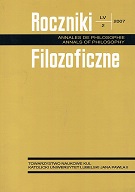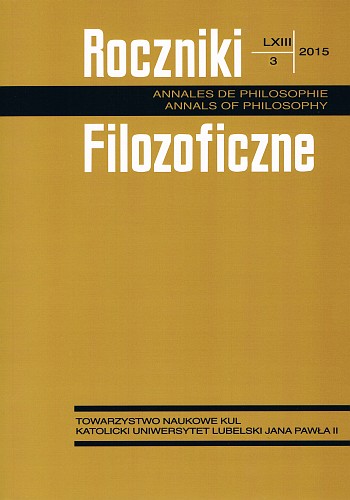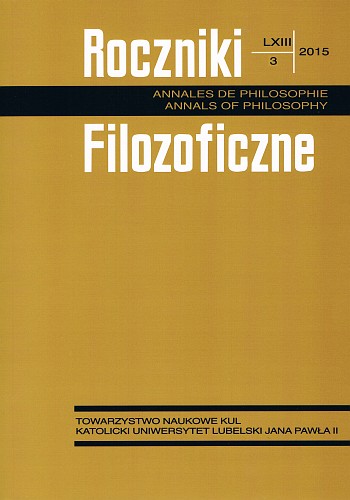
We kindly inform you that, as long as the subject affiliation of our 300.000+ articles is in progress, you might get unsufficient or no results on your third level or second level search. In this case, please broaden your search criteria.




In the second part I discuss Frege’s and Hilbert views on the nature of mathematical proof, in particular their discussion concerning the problem of implicit definitions. I also discuss Hilbert’s program and conclude with some remarks concerning the problem of the “decline of intuition” in the formalistic conception of mathematical proof.
More...

This article is the first one to examine the evolution of the notion of mathematical proof in a historical perspective. First I present the intuitive, approach of Descartes, according to which mathematical proof is based on self-evident principles. I follow with an analysis of Berkeley’s mathematical instrumentalism and argue that he can be considered a predecessor of modern formalism. The article also deals with the ideas of Peacock and Pasch, and their role in the development of the modern formalistic viewpoint.
More...
The purpose of this article was to present the meaning of the desert in spiritual thought of Peter Damian. In the first part we presented a short biography of Peter Damian has provided insight choices in spiritual life. In the second part we showed his conception of the spiritual life that was inspired by the life of his spiritual master—St. Romuald. Peter Damian distinguished two ways in monastic life: community life and the solitary life, hermit. Community life is a kind of preparatory for the solitary life. In a third part we presented the value and importance of the hermit’s life and the difference between community life and the solitary life. Peter Damian pointed out that the desert and the cell is the perfect place for the monk who wants to achieve perfection in the spiritual life. Life in the desert is the surest way to attain salvation because it separates us from the world and it gives more favorable conditions for prayer, contemplation and ascetic practices in union with God. The desert is the place where it is exercised in virtue by fasting, silence and prayer, but also a place of combat with vices and with Satan. The desert is a vital passage for those who want to reach the top in the mystical life.
More...
The article is a presentation of the most important features of Meister Eckhart’s apophatic theology that is firmly rooted in the thought of Pseudo-Dionysius the Areopagite. The author presents a kind of dialectic cognizability and uncognizability of God, illustrating this abundant examples of Eckhart’s Sermons. In the text, another very important issue was also discussed, namely the relationship between Eckhart’s henological, rooted in Neo-Platonism, vision of reality and the Christian doctrine on the Trinity. The author has stated in the Marie-Anne Vannier’s opinion, that Eckhart is a “virtuoso of Trinitarian theology,” but adds that he always leaves a place to live the mystery.
More...
This article considers the issue of changes in the understanding of symbols as an integral part of spiritual life in Neoplatonic philosophy. It seems that ancient Neoplatonic philosophers were the first who clearly realized the importance of symbols to spiritual life. However, it happened due to the influence of the mystical Chaldean and Egyptian thought transferred to philosophical investigation by the Chaldean oracles and Corpus hermeticum. The late Neoplatonic thought of Iamblichus and Eastern Neoplatonic schools used symbols and rituals as integral parts of philosophical investigation, understood as having a mystical goal. Especially mathematical symbols played a significant role, because they were used in the most advanced theurgical rituals. This analysis of the pagan Neoplatonic philosophy permits us to show properly the thought of Pseudo-Dionysius the Areopagite, who creatively transformed the teaching of his pagan predecessors, by incorporating ancient Neoplatonic tradition into Christian theology. Pseudo-Dionysius excludes liturgical symbols from the order of the cosmos and transfers them to the plane of Salvation grounded in Biblical Revelation. Only true symbols are used in the liturgy of the Church, and thus mathematical symbols are no longer needed in the ascent of the soul to unity with God. The third part analyzes the meaning of symbolism in the thought of Nicolas of Cusa. Thanks to the rediscovery of ancient pagan Neoplatonism and Pythagorean thought, Cusanus also brings new life to the mystical meaning of mathematics. Mathematical symbols once again become an important part of the mystical ascent of the soul, but this time without their ritual context.
More...
Part II explains molecular background of the memory based on the assumptions of Neuro-Electro-Dynamic postulated by Aur & Yog. Biophysical mechanism of memory formation was indicated responsible also for senses and reflections through the ephatic inter-postsynaptic functional coupling which can induce Vadakkan semblions. WTA selective mechanism was proposed as the base for the model of attention switching. Relations between working, short term and permanent memory were indicated and their coherence with molecular memory formation process and pattern recognition. It was shown, permanent episodic memory requires bottom-up signals time sequence conversion to the spatial distribution patterns forming dynamic semblions Past episodes reminding is possible by reciprocal transformation of these semblions. Innate neural network structures was discussed which ensure instinct behavior inheritance. These structure doesn’t exclude mind plasticity necessary for effective learning.
More...
In the article, the Author tries to show that the ethics of care, and more precisely, some of the demands of its prominent representatives, may lead to the disappearance of care in its fundamental meaning. These proposals aim to extend care to the socio-political relations. The thesis is proved by using the typology of care.
More...
The article discusses one of the early sermons by Nicholas of Cusa—Sermo VII Remittuntur ei peccata multa, written in a dialogue form, uncharacteristic of the sermon genre. The main protagonist is Mary Magdalene, who was described on the basis of biblical and apocryphal stories. According to Sermo VII she is an allegory of the soul’s love for God. The article contains the analysis of Cusanus’ concept and terminology of love (amor, caritas, dilectio) as well as the description of the image of three and seven stages of love. Moreover, there have been identified intertextual relations between the sermon and sources attributed to Bonaventura such as De diaeta salutis by Guillaume de Lanicia and De septem itineribus aeternitatis by Rudolf von Biberach. Finally, there are also deeper semantic analyses of more difficult fragments.
More...
The term mysticism is often employed as a religious category whose meaning, in ordinary language, is fuzzy and unclear. Attempts to define it in reference to the history of philosophy and by means of interdisciplinary approaches in the natural sciences and the humanities alike have proven to increase and polarise its ambiguity. Theological reflections, in contrast, appear to provide a more solid understanding of the specific religious life forms belonging to the term mysticism. Indeed, these reflections seem to provide certain strategies that have proven to be capable of addressing the question of human union with God. Still, the attainment of an appropriate understanding of mysticism does not only presuppose a deep understanding of the different models concerning a mystical union. Rather, it also presupposes a close familiarity with the philosophical and religious traditions which build the theoretical backbone and the necessary instrument for mystical speculation in general. The purpose of this paper, then, is to uncover some of these presuppositions in one of mysticism’s most famous historical proponents, Albert the Great († 1280). Albert—the universal thinker of the middle ages and founder of the Dominican School—has long been recognised as forerunner to the famous Rhineland Mysticism, propounded by illustrious medieval thinkers such as Dietrich of Freiberg, Meister Eckhart, and Henry Suso (Heinrich Seuse). Consequently, his views on mysticism have been subject to an ongoing and oftentimes heated scholarly debate that is principally led by Alois M. Haas, Kurt Ruh, Werner Beierwaltes, Ruedi Imbach, Burkhard Mojsisch, Alain de Libera, Kurt Flasch and Loris Sturlese. In the context of these debates, then, my paper is meant to add a truthful portrayal of Albert’s views on mysticism.
More...
In this article the author deals with a theme of mystical speculation that regards the question of whether the human being can reach a complete union with the origin or principle of being within the context of Nicholas of Cusa’s notion of imago repraesentationis. In Nicholas of Cusa, this question is posed in terms of the unfolding of the human being’s freedom, as imago imitationis creata, through that personal union with the Absolute.
More...
Meister Eckhart, a figure often very controversial, enjoys the interests of theologians, philosophers and mainly mystics. The main reason for this interest is his concept of a mystical union based mainly on the issue of the spark of the soul and the lower part of the soul which becomes almost the same as God. According to Eckhart, on the one hand, we are born and on the other, we are not, as we are supposed to expect to be born in the lower part of the soul. “The birth of God in the soul”—this is how Meister Eckhart describes the mystical union which, according to him, should be placed in the category of theosis (divinisation). The source of the theosis is nothing else but a strong resemblance between God and the human—specifically his soul. It is not hard to find numerous similarities between the concept of Eckhart and pagan Neoplatonist concepts of Plotinus or Proclus. There are many premises which state that Meister Eckhart is trying to combine the idealist Neoplatonist philosophy and the entirely rational philosophy of Thomas Aquinas, however, the aspects of Aquino are almost unnoticeable in the Meister Eckhart’s ideas. It seems that numerous difficulties connected to the interpretation of his views are a result of an evident lack of metaphysics in his work. It is a little bit odd taking into account that the Meister Eckhart knew vews of Thomas Aquinas who developed the unambiguous concept of “being”. The process of unification is shown by Eckhart in the context of knowing. It is the intellect that is the power of the human being that enables him to remain in a ceaseless union with God and by that—to rise. That is why the road to the union with God will always be the road to the Supreme Intellect achieved by perfecting one’s own intellect. However, it is a process that demands to transcendent beyond oneself. This transcendence is to aim for simplicity, that is to reject all variety and otherness. In this way a poverty is reached, which is understood in a completely paradoxical way, because as a result of the union with God it seems to be the greatest wealth. Nevertheless, it is worth remembering that the mystical contact with God is not only external for the human. This mystical union is not based on the rising of the soul to God, but on the appearance of God in the lower part of the soul, as the higher part of the soul, that is the spark of the soul, is the same as God. The birth of God is the participation of the lower part of the soul in the joy of the spark of the soul. Eckhart explicitly indicates that means the birth of the Son in the soul, but not distancing his soul from the Father. It is still the same kind of union. The individuality of a human is abolished, his identity is blurred. This ontological union with God himself is at the same time a union with goodness itself, that is why all moral dilemmas fade away as they are solved thanks to a complete union in which there is no diversification between the identity of a human being
More...
I offer a reading of my book One Body on Christian sexual ethics as an application of Inference to Best Explanation based on theological and philosophical data.
More...
Throughout his excellent book One Body, Alex Pruss relies upon the view that there is a requirement of universal love: each and every one of us is required to love each and every one of us. Although he often appeals to revealed truth in making arguments for his various theses, he supports the requirement of universal love primarily through a philosophical argument, an argument that I call the “argument from responsiveness to value.” The idea is that all persons bear a sort of nonrelational value, and because this value gives every agent reasons to respond to it positively, each and every person is bound to love each and every person. The aim of this paper is to criticize this argument. Pruss’s argument has two important gaps, one concerning the sort of reasons that the value of persons gives and one concerning whether the required response is the response of love.
More...
Throughout his excellent book One Body, Alex Pruss relies upon the view that there is a requirement of universal love: each and every one of us is required to love each and every one of us. Although he often appeals to revealed truth in making arguments for his various theses, he supports the requirement of universal love primarily through a philosophical argument, an argument that I call the “argument from responsiveness to value.” The idea is that all persons bear a sort of nonrelational value, and because this value gives every agent reasons to respond to it positively, each and every person is bound to love each and every person. The aim of this paper is to criticize this argument. Pruss’s argument has two important gaps, one concerning the sort of reasons that the value of persons gives and one concerning whether the required response is the response of love.
More...
This paper contests an important assumption guiding Alexander Pruss’ One Body, that marriage is intimately connected with love, including romantic love. This assumption, I argue, is the product in part of a distinctively modern understanding of marriage. To show this, Pruss’ position is set against the premodern, and in particular the Byzantine Christian, view and practice of marriage, where marriage was not grounded to any significant extent on (romantic) love. Finally, some indication is provided as to why romantic love was disassociated from marriage in medieval Christian culture.
More...
In this essay I explore Alexander Pruss’ conceptions of love and sexual desire. I argue that he fails to provide a convincing account of either and that one reason for this is that he ignores far too much relevant material in philosophy and the arts that needs to be taken into account in a thorough investigation of such matters. I argue further that Pruss’ understanding of love and sex is highly moralized, meaning that his discussion is not at all sensitive to the actual human experience of these, but consistently falsifies them. I also argue that the teleology to which Pruss appeals in order to ground his claim that, in the sexual act, the bodies of the lovers are striving for reproduction, is implausible and, further, that, even were it not, we could not infer from such teleology the moral conclusions that Pruss wishes to extract from it.
More...